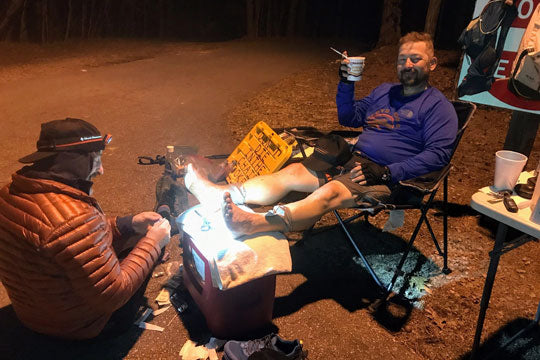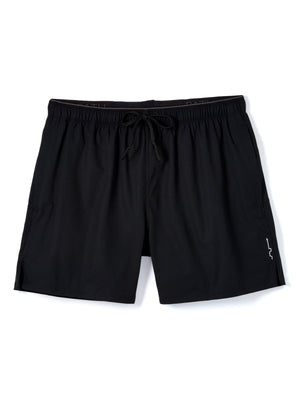In today's guest post, John Goldfield from our KREW shared valuable lessons from the "other side" of running 100 miles.
Recently he worked as overnight Aid Station Captain at the Umstead 100 mile race and he paced a friend running his first 100 miler (MST 100). Read below for a recap of his experiences. Also, find more ultra running stories on his blog Finding Awesome.

John Goldfield: I had the lucky opportunity recently to supplement my training cycle approaching Zion 100 with two amazing experiences. My “trail brother” Chris was set to run his first 100 mile, the MST 100, and had asked me and another friend to crew and pace him. Being 4 weeks out from Zion I felt it'd be a perfect nighttime long run to practice and I looked forward to supporting his effort through the day too. Chris had been denied TWO prior 100 mile attempts in 2020 related to the ‘Rona, so this meant a lot to him.
Last year I had committed to covering the overnight medical needs at the second-of-two major aid stations for Umstead 100. When Covid cancelled that I promised to work the 2021 version. RD Rhonda Hampton ran into me on the trails one day and said “Hey John, how’d you like to Aid Station Captain overnight too?”. Never one to say no to Rhonda, I jumped at the chance, though I had no real idea what it entailed. This overnight was to be one week after Chris’ race… and… I was already working that weekend, This meant I’d be working a shift during the day, going out to the Aid Station overnight, and then getting a quick nap in the am before going BACK to work the next day! More fatigue and time-on-feet training ahead of my race, right?
To say that these two experiences leading up to my own effort were “helpful” is a gross understatement. Not only did I have an amazing time and tons of fun, I learned valuable lessons I hope to take with me into the high desert of southern Utah and the Zion 100. Here are some things I learned from participating in a different side of a 100 mile trail race:

Crewing Coker for his first 100 miler:
Planning: I am a planner… a list maker… a spreadsheet guy. Not everyone is, but I find it extremely helpful not only to ensure the details of the race go off smoothly, but honestly just to give my brain something to do in the weeks/days ahead of the race. Chris’ crew were the list makers, not him… but it made it much better and more efficient as we went through the day/night and made sure we had whatever he needed.
Expectations: It turns out your regular pace on any given trail varies from day to day and with different conditions. This day had significant mud and wetness for the first 30+ miles which in turn affected the entire rest of the race.
Good communication: It goes without saying… but SO important during the race. Being able to get in touch with our runner and get a feel for what he was needing really helped.
Self-Care: all-day, all-night, and part of the next day… it’s a long time. For the runner of course it’s literally about pacing and physically addressing needs of the body. For crew it was some of that too, but also the hours spent waiting and worrying about our runner. So important to keep everyone in good shape, happy and well fed!
Foot Care: Gotta keep those feet dry as much as possible. There’s a point in most ultras where there are stream crossings etc… good drawing shoes, wicking socks and lubricant are key. But when the moisture is inescapable for too long… bad things happen to feet.
Lighting source: Have a light source with you earlier than you think. We stood at the 53 miles aid station watching dusk approach… it was lovely, watching the colors fade and mute… until we realized that in the woods Chris was pretty much approaching pitch black. His light was waiting with us. Again… expectations and pace variables. I’ll plan to have a headlight way earlier than I think I need it.
Music: for some reason both 100s I’ve run I did so without once putting headphones in for some tunes. I CARRIED them the whole race, but never felt I needed them. Pushing along in the looong last miles with Chris, we sang out loud to Bill Withers, we grooved to Bob Marley and even found a slightly higher power-hiking gear to Daft Punk.
Good AS setup: camp stove, kettle, pan, lantern, extra propane, extra jugs of water (sometimes the shared containers taste funky) extra runner supplies (The runner should set it up but encourage extra lube/favorite drink mix/gels/food/socks/shirts)

Umstead 100 Ptomaine Tavern (Aid Station 2):
The Umstead 100 mile Endurance Run has been in existence for 27 years (26th running this year due to Covid last yr) and is held up as one of the best races on the East Coast. Most of what makes this race so incredible is the organizers, volunteers and local community that comes together to make for an incredible experience year after year. I volunteered for a few hours in the evening in 2017. I came back in 2018 to pull the 2am to 6am shift but stayed longer because I just didn’t want to miss any more of the amazingness.
Those experiences were pivotal in my decision to train for and run it in 2019. I was just a wide-eyed (51 yr old) kid back then and didn’t know lube from shine-ola. I wasn’t plugged into the community of trail runners like I am now, but I could SEE what was going on there… it was like magic. So inspiring and exciting. Seeing the wide variety of folks out there being frankly amazing: old & young, and “normal”, seasoned and newbie. Everyone was experiencing their own personal challenge and finding the grit and determination needed to finish. I knew I had to try to complete this race myself.
Training for, and running Umstead in 2019 quite suddenly opened up a whole new world of the local trail running community. I discovered “my people”. I found circles of friends that overlapped with other circles of friends, and running stores where people know your name even before you’ve ever walked in the door!
Fast forward to the 2021 running of the Umstead 100.
To talk about everything that the night brought would be an essay unto itself. Suffice it to say it was a blast and at no point did I feel sleepy or wish I was home in bed. I absolutely LOVED supporting friends and strangers as they powered on through a night that brought warm humidity, torrential rain, thunder and lightning, and then chilling breezes in the wee hours as well. The race RD and main group of organizers succeeded in pulling off a monument of logistics and coordination once again, as they have year after year, and this time with Covid restriction hurdles as well.

Aid Station and Medical Support lessons learned:
Atmosphere: The AS is a beacon in the night for runners. They look forward to the mental and nutritional boost they will get. Bright lights and music along with energetic volunteers is EVERYTHING. There was a Bluetooth speaker there and I kept it bumping ALL night with a total random mix of fun classic rock and 70’s/80’s dance music. It was a par-tay.
Spare clothing bin: what a great idea! Saved one runner who was soaked to the bone and bordering on hypothermia. She went home in a mish-mash of crazy clothes, but she was dry and happier.
“Sour stomach”: a common complaint mostly due to the heat… runners just couldn’t keep things down OR just had no desire to eat or drink for way too long and were now low on calories and dehydrated. Symptoms were mostly feeling ill, but many were incredibly fatigued, lightheaded and wobbly, dizzy etc… The fix? Sit. Sip. Eat. Repeat. Really… I’d have folks just sit for 10-20 minutes… sipping on Coke or Ginger Ale and nibbling pretzels or something. All but one of them got outta there and finished the race. (one poor guy was so bad off that we literally dragged him into the tent to lay down and I had to convince the young MD who was volunteering with me that he didn’t need an ambulance juuuust yet.)
Blisters: they were BAD because everyone was so wet for so long. We could patch some up… but the rule I soon realized was that there was no way to “fix everything”. I eventually had to convince runners (and my medical volunteers) to leave many blisters along and only deal with the really painful ones (on the balls of the feet or heels). Sometimes “less is more”, having someone sit for an hour to treat every little blister does not pay off in the long run.
The “Give It 10 Minutes” theory: Almost any condition (fatigue, motivation, overheating, dehydration, sour stomach, painful feet, bad attitude…) can in fact improve just by taking 10 minutes to pause and reset. 100 miles is a long time, and unless you’re chasing cutoffs, you can save a race just by taking that extra time.
Blister kit supplies: compound of benzoin, sharps(needles or scalpel), sharps container, alcohol to clean/dry, medipore tape (or similar “blister tape”), moleskin, powder, band aids, headlight, reading glasses (for us old folks), gloves.
Both experiences are something I look forward to repeating. Both taught me valuable lessons about what I want from my crew and what I hope to get out of Aid Stations in upcoming races. I’m definitely committed to Captaining overnight again, so next year’s Umstead runners can look forward to great music, fun atmosphere, uplifting and energetic volunteers and hopefully the huge boost they need to finish each lap and get their buckle.






